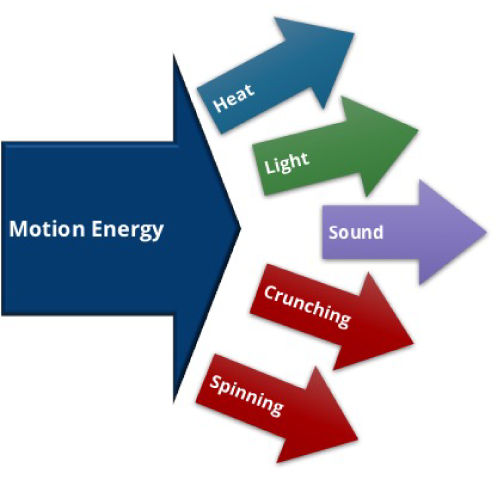Last week on SiriusXM Speedway, we talked about how the kinetic energy of a race car (at 190 mph) is approximately equal to the caloric energy contained in two dark chocolate Easter bunny rabbits. The serious fact is that when a car comes to a stop, all of the kinetic energy has to go somewhere. It has to be turned into other forms of energy, preferably without any of that energy going into or through the driver.

Technically, we call those last two deformational energy (crunching) and rotational energy (spinning), but I think my names are more descriptive, frankly. All of that kinetic energy gets turned into another type of energy according to the principle of conservation of energy:
Energy cannot be created or destroyed: It can only change forms.
Gary McGinnis (@GPM018) asked about what happened to the energy after it changed from kinetic to these other kinds of energies. Then it goes away, right?
This is a really good question — and the kind of question I love because it tells me the questioner is really thinking!
Energy is STILL conversed. The problem is that it’s very hard to see that this is true because energies like sound and heat are dissipative — they spread out the energy so that it looks like it’s disappearing.
Let’s use a non-energy analogy first. Let’s say I give you a million dollars, but you (being a kind and generous person) want to share it. So you keep one-tenth ($100,000) and give the other 9/10 to nine of your friends. There are 10 people each with $100,000. It’s still a million dollars, but it’s distributed over ten people.
Then each one of your repeats the process. You give one-tenth ($10,000) to each of nine more friends (and your nine original friends to the same). Now there’s 100 people, each with $10,000 dollars. You can see where I’m going with this. Eventually, there are a million people, each with one dollar.
It’s still a million dollars, but it’s distributed over so many people that each person has just a tiny bit more money than they had before you came into your windfall. You haven’t lost any of the money, you’ve just spread it out.
Dissipative forms of energy work the same way. Let’s say I clap, which transforms the kinetic energy of my hands into sound energy. When I clap, I move air molecules. Each of the molecules closest to my hands then move the molecules next to them. It spreads, just the way sound spreads.
(Aside: If you haven’t seen the video of the speed of sound at a Live Aid concert, you must. A more complete article is the video is on Nerdist.)
Back to energy:

Anyway, the energy from the hand clap spreads just like you spread out the fictional million dollars I gave you. After awhile, there are so many molecules sharing the energy that each one has a tiny, tiny, tiny bit more energy than it had before the hand clap. It looks like the energy has disappeared, but it hasn’t. It’s dissipated.
We use the term dissipative to refer to energy that is hard to get back once it’s been transformed. If you had a frictionless track, a roller coaster could run forever with no added energy. The gravitational potential energy at the top of a hill would be converted to motion energy, then the motion energy would go back to gravitational potential energy when the car went up the hill. It’s easy to change the two forms back and forth.
Dissipative energies (like friction) take the energy and spread it out over so many places that you can’t readily gather it back up again.
Please help me publish my next book!
The Physics of NASCAR is 15 years old. One component in getting a book deal is a healthy subscriber list. I promise not to send more than two emails per month and will never sell your information to anyone.
Discover more from Building Speed
Subscribe to get the latest posts sent to your email.


Be the first to comment